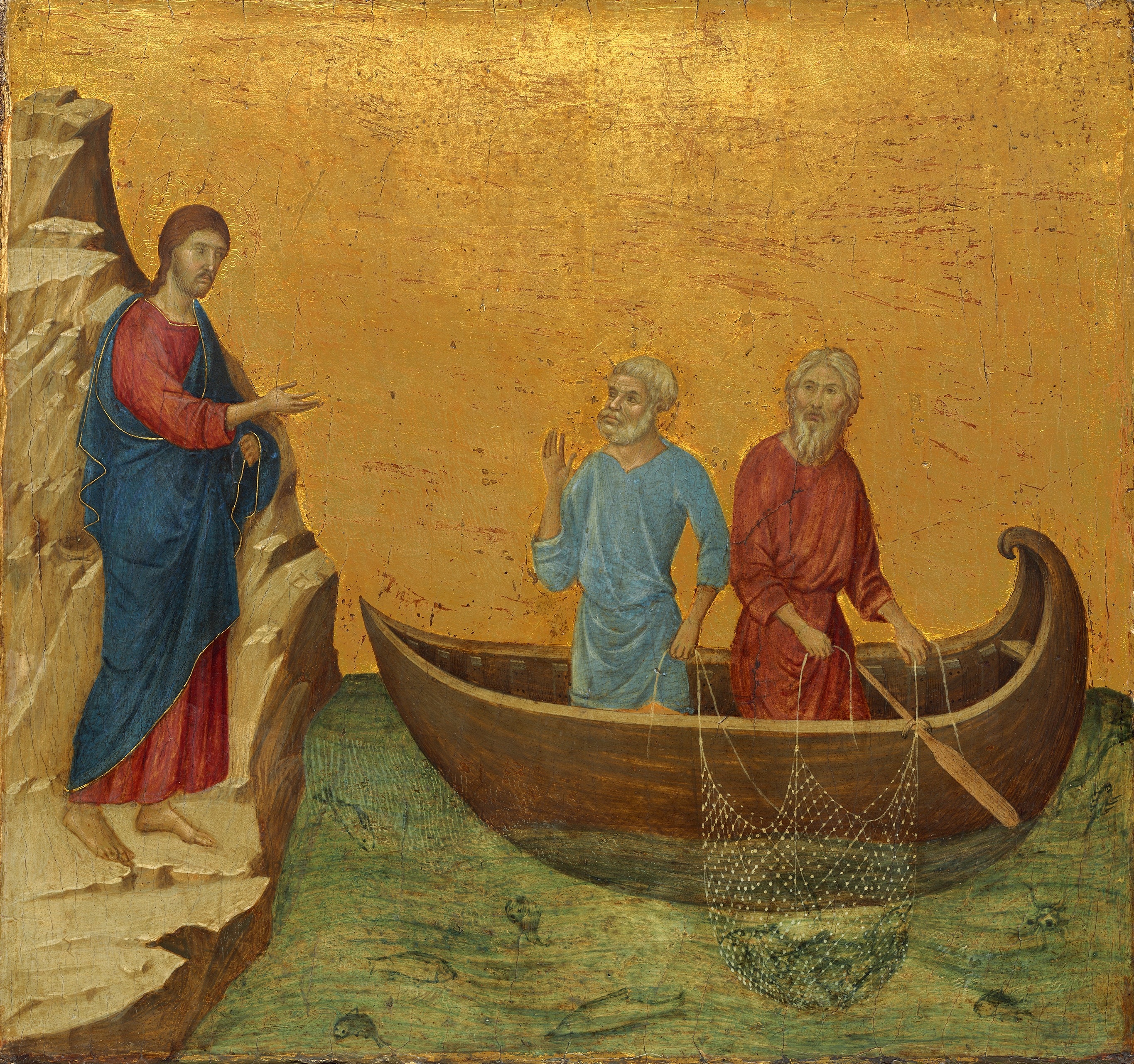Jesus Call His First Apostles
Luke 5:1-11
On one occasion, while the crowd was pressing in on him to hear the word of God, he was standing by the lake of Gennesaret, 2 and he saw two boats by the lake, but the fishermen had gone out of them and were washing their nets.3 Getting into one of the boats, which was Simon’s, he asked him to put out a little from the land. And he sat down and taught the people from the boat.
4 And when he had finished speaking, he said to Simon, “Put out into the deep and let down your nets for a catch.” 5 And Simon answered, “Master, we toiled all night and took nothing! But at your word I will let down the nets.” 6 And when they had done this, they enclosed a large number of fish, and their nets were breaking. 7 They signaled to their partners in the other boat to come and help them. And they came and filled both the boats, so that they began to sink.
8 But when Simon Peter saw it, he fell down at Jesus’ knees, saying, “Depart from me, for I am a sinful man, O Lord.”9 For he and all who were with him were astonished at the catch of fish that they had taken, 10 and so also were James and John, sons of Zebedee, who were partners with Simon. And Jesus said to Simon, “Do not be afraid; from now on you will be catching men.” 11 And when they had brought their boats to land, they left everything and followed him.
Observations & Reflections
 The first thing that one should notice about this passage is how quickly the fishermen prepared a boat so that Jesus could teach just off of the shore. What a strange thing to do, it would seem. Why teach a few feet off the shore in the middle of a boat? The simple answer is that Jesus needed insulated from the crowds. It was logistical. He didn’t want to be injured or attacked by the crowds as He was in His home town.
The first thing that one should notice about this passage is how quickly the fishermen prepared a boat so that Jesus could teach just off of the shore. What a strange thing to do, it would seem. Why teach a few feet off the shore in the middle of a boat? The simple answer is that Jesus needed insulated from the crowds. It was logistical. He didn’t want to be injured or attacked by the crowds as He was in His home town.
Second noticeable characteristic about this passage is that Jesus calling of the apostles is slight different in Luke verses the calling in John 1. In John 1, Peter is not even present and he is requested by Jesus, through his brother Andrew.
Again the next day John was standing with two of his disciples, 36 and he looked at Jesus as He walked, and said, “Behold, the Lamb of God!”37 The two disciples heard him speak, and they followed Jesus. 38 And Jesus turned and saw them following, and said to them, “What do you seek?” They said to Him, “Rabbi (which translated means Teacher), where are You staying?” 39 He said to them, “Come, and you will see.”So they came and saw where He was staying; and they stayed with Him that day, for it was about the tenth hour. 40 One of the two who heard John speak and followed Him, was Andrew, Simon Peter’s brother. 41 He found first his own brother Simon and said to him, “We have found the Messiah” (which translated means Christ). 42 He brought him to Jesus. Jesus looked at him and said, “You are Simon the son of John; you shall be called Cephas” (which is translated Peter).
As Luke tells the story, Simon Peter was with Andres the day that he called the disciples. However, in John’s telling of the story, there were 2 disciples of John the Baptist that initially followed Jesus and it was after John called Jesus the Lamb of God. One of those two that followed Jesus was the brother of Simon Peter. He tells Peter about Jesus and then introduces them. This is altogether a different order of events.
However, there is a rather simple way to reconcile these two accounts. If we assume that John’s story which covers 2 days is giving more information that Luke’s account. Luke’s account is just one day and it appears to be be day #2; the day the Simon Peter has already been introduced to Jesus. This would make sense because in Luke’s account it appears as though Jesus already knows Andrew and Simon by name and they appear to already call him master.
Another key piece of information is that on the day Peter had his name changed, he was with his brother, Andrew (day #2). This holds up with Luke, Matthew, and Mark.
As Jesus was walking beside the Sea of Galilee, he saw two brothers, Simon called Peter and his brother Andrew. They were casting a net into the lake, for they were fishermen. (Matthew 4:18-19)
Note that in Matthew’s account the audience is informed that Simon’s other name is Peter, which could mean that Matthew is telling somewhat of a summarized version that explains that Peter used to be named Simon. The versions in John and Luke are expanded versions of the account told by Mark. However, Luke’s account seem to focus on the event of day #2, whereas John covers 2 days worth of events.
[Featured image by Duccio di Buoninsegna, titled “Calling of the Disciples, Peter and Andrew”]
